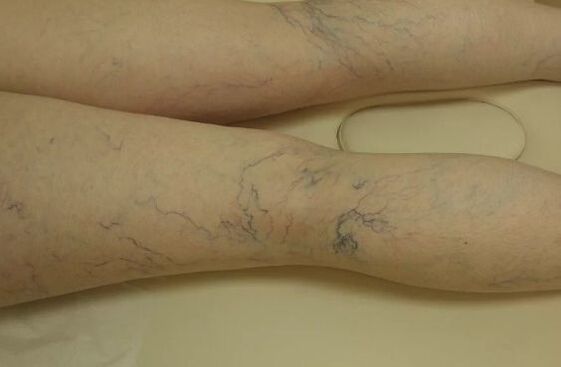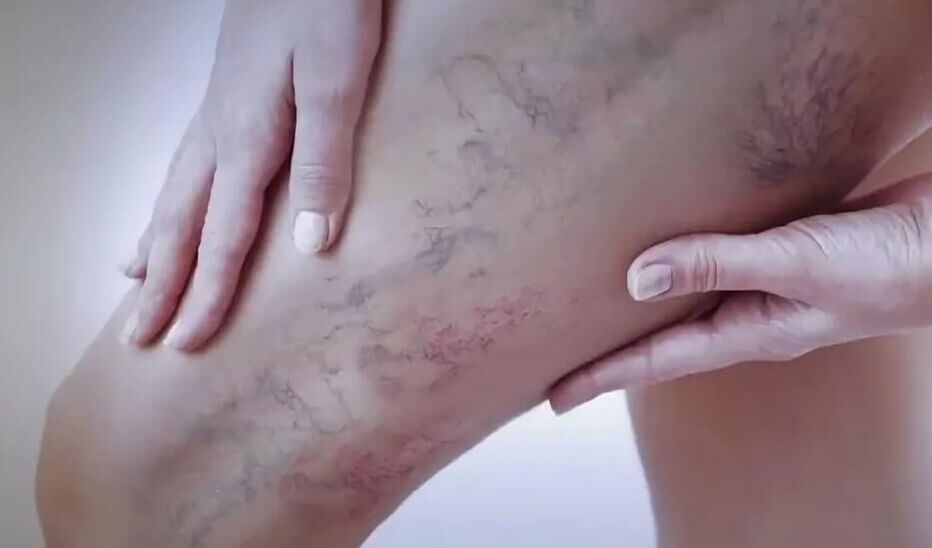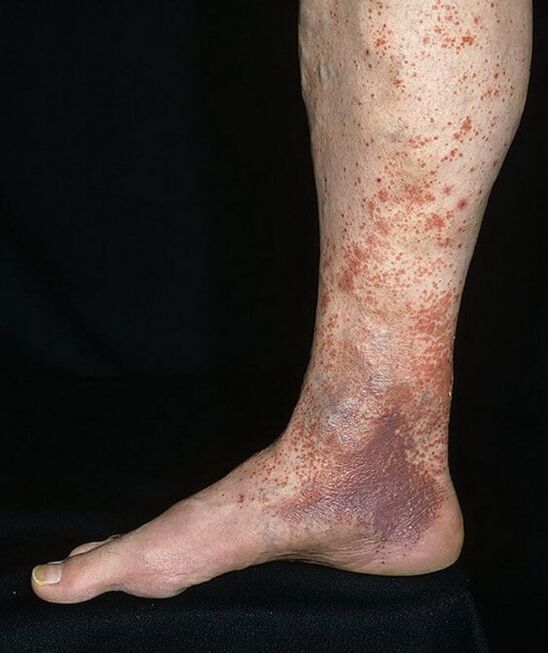The varicose veins in the legs are a chronic change in the output of the blood as a result of the influence of mechanical, toxic, traumatic or other factor.
To better understand the essence of the pathological process, you need to refer to anatomical information.
The lower limbs are provided with two main ways:
- In arterial branches.They carry oxygen -rich blood, which only provides useful compound cells.
- Through the veins.Liquid tissue tolerates carbon dioxide and unnecessary substances for processing, in the reverse blood movement of structures, the veins are involved.
It should be noted that different types of blood vessels are not connected or reported, the systems are completely closed.
Blood through the veins moves strictly in one direction.The muscle layer in these structures is quite weak, all the work falls into special valves.They are like partitions, doors that do not pass the liquid fabric in the opposite direction of the applied.
Against the background of venous pressure increase, injuries, damage and other factors, the valves weaken.The blood moves backwards, the load on the walls of the blood vessels increases.Vienna wears out often faster.
Under the mechanical effect, dial structures change their properties and sizes.The varicosis itself begins.
This disease is characterized by deformations of blood vessels, a decrease in its functional activity, protrusion of the aneurysm of the walls throughout the length.
Varicherosis is dangerous, because over time it leads to a pause in the vein, the formation of blood clots, the death of local tissues.Treatment should begin immediately, from the moment the pathological process is detected.
A feature of a disorder is a relatively unhurried progression.The main contingent of patients are men and women over 18 years old.
Despite relatively without hurry, the disease behaves unpredictably.Never say in advance at what extent critical complications will develop.
A doctor who treats the disease is a phlebologist.
Development mechanism
The pathological process is based on heterogeneous factors, if they are widespread and composed of an approximate image, the options will be as follows:
Mechanical influence
Increased physical activity in leg veins.It is found, for example, with intensive sports.The most common options are characteristics of professional activity (builders, teachers, cooks and others suffer), increased body weight, as the leg load grows.
There is all the chances of overcoming the pathological process in time on your own.The main thing is to eliminate the abnormal factor.
Traumatic lesions of surrounding tissues
Not the veins themselves, but the areas around.Hematomas of soft structures, muscles, ligaments, partial and complete fractures.
There are two reasons for the development of varicose veins: compression of blood vessels with altered tissues and also unequal redistribution of loading in the lower limbs.
Interestingly, the culprits of varicose veins can also be diseases of the musculoskeletal system: arthritis and the like.
Leg leg compression
This refers to external influence.Blood flow violation usually causes patients with their own irrational actions.
For example, the use of tight pants or tight socks is affected.Especially similar are women who are ready to put health participation in the pursuit of beauty.
By compressing the legs of the region, which are below the compression site, they are subjected to stagnant processes.The venous-lumphics output is significantly disturbed.This leads to quickly progressive varicose veins.
There are cases where the pathological process began later, years after negative influence.
Violations of hormonal balance
The production disorders of thyroid gland substances, adrenal glands and pituitary gland are affected.
Change can affect other compounds: reproductive system hormones, androgens, estrogens.They partially regulate the tone of great vessels, veins and arteries.
Genetic characteristics
The history infused, according to research, plays almost the main role in the development of the pathological process.This is not a trigger, but a clear premise that increases probability several times.
Obviously, the presence of a relative who suffered from varicose veins is not a guarantee of the development of the pathological process, but the probability is significantly greater.
It is necessary to adhere to the rules of prevention to minimize risks.
Hypovitaminosis
For normal work, regeneration of veins, arteries, ascorbic acid is required.In addition, group B vitamins, and D. There can be no normal restoration of blood vessels without them.They wear out quickly, lose their old elasticity.
If the state of disability lasts enough, from several months, not to avoid changes in the veins.
The disease develops faster than normal, progression to a pronounced and dangerous stage takes only a few months, at most a few years.
Congenital vessel anomalies
Visions, as a rule, do not develop in isolation.Other deviations can be found.Therefore, diagnoses are not of problems.
Natural states
Pregnancy, severe birth, characteristics of hormonal history in adolescence or closer to old age.
There are other mechanisms that are less common.For example, intoxication, exposure to the radiation body and others.The most common are named.
Varicose veins are a disease that is characterized by a deviation system: vein deformations, aneurysm formation, stars, inner lining thinning.The influence of a group of pathogenetic factors is possible.
Classification
Unit methods are related to the stage of the pathological process, its form.About everything in order.
The technique adopted in medicine distinguishes three degrees of disease development:
- Plywood.Symptoms are absent, the patient makes no health complaints.The pathological process at the beginning of its development.But there are already visible signs: the dilated veins stand out for the thickness of the skin.For several years, the violation will go to a new stage.
- Subcompensation.Clinical signs of varicose vessels are clearly expressed.Among them, you can distinguish pain, gravity in the legs, a feeling of racing of goose bumps, weakness, seizures at night.After rest, they have nothing.Visible manifestations are also present.You can make a diagnosis without problems.
- Decompensation.In addition to the symptoms already mentioned, additional: leg numbness, loss of sensitivity, common rash, constant itching and areas of injury burning.
There are real risks of tissue necrosis, thrombosis.Treatment is urgent, otherwise - not to pass the deficiency.
Standing

There is an international typification generally accepted from the pathological process in internships (classes):
- 0. The visible symptoms of the disorders are minimal.Patients talk about severity at the lower ends.This phase can last indefinitely.
- 1. The stars form on the surface of the legs, the veins are expanding and become clearly visible.The clinic is still the same.The maximum episodes of night seizures develop, which are more quickly and suddenly interrupted.
- 2. Clinical signs are identical.With a visual evaluation of the lower ends, the doctor reveals visible changes of vein varicose veins: they branch, project and form complex deformations.
- 3. From this stage, the pronounced edema begins.
- 4. Sluding rashes appear, with itching in the variza dermatitis.The skin above the surface of the lesion changes the shadow to the dark, compact and dry significantly.It becomes thin, because any mechanical effect causes painful and deep combs.
- 5. Small erosions appear.
- 6. Complete trophic ulcers are developing.
For the complete formation of the pathological process, from 0 to 6th stage, it takes up to several decades.
Symptoms
The clinical picture depends on the disorder phase.If you present an average list of demonstrations, the list will be as follows:
- Leg weight.Especially after a mechanical load, a long -term working day.Walking, standing in a place becomes problematic.Over time, the symptom intensifies only, which indicates the progression of the violation and allows it to suspect varicose veins at the early stage.
- Physical activity intolerance.At first, the patient cannot walk for a long time and then stand up.If you start a disorder, you will only get worse.A person will not be able to climb the stairs without long intervals, pauses.This is due to venous lymphatic stagnation in expanded veins.
- Pain of different intensities.In the early stage they are absent.After a few months or years, the severity of the demonstration is growing.Dumb and uncomfortable sensations begin.
They intensify after physical activity, with a sharp change in the position of the body.
 In the final stages of the disease, the symptom constantly remains with the patient, does not disappear.
In the final stages of the disease, the symptom constantly remains with the patient, does not disappear. - Visual changes of ships.They seem like abnormal branch, the formation of stars in the legs.These manifestations clearly indicate the beginning of varicose vessels.Therefore, the diagnosis over time is becoming easier.It remains only to clarify the location of the changes and their diploma.
- Swelling.They gradually start, approximately with the second or third stage of the pathological process.First - until the end of the day.Pass after a night of rest.Then changes in volume are constantly preserved, do not end.As a rule, the signs are related to the first and then the other leg.
- Cramps in the dark.In violation of muscle tone, cramps, is one of the first signs of varicose veins due to the deceleration of venous lymphatic output, tissue trophies and cellular respiration.
Cramps on the legsThey prevail at night, accompanied by very severe pain.The patient cannot be in the affected leg during the day, or even several.Gradually, the frequency of spasms becomes only higher.
- Itching on the skin.An alarm sign of varicose veins that characterizes gradual dystrophic disorders.In the early stage of erosion, there are no ulcers yet.But this is a matter of time.
- Changing the shadow of the dermis.Hyperpigmentation.The darkening of the surface of the skin.Closer to the final phase of the pathological process, the leg part acquires a rich raspberry hue.
A characteristic symptom of the varicose veins of the lower ends is the skin seal above the lesion, which is associated with gross tissue scars under the surface of the epidermis, the outer layer of the skin.
- The formation of a rash.Varishing dermatitis so.This is a harbinger of the final stage of the pathological process.The small papules are very itching, they do not allow the patient to live normally.Complications are possible, secondary infection of wound surfaces.
- Trophic ulcers.A clinical sign, characterized by the formation of great erosion, fabric decay focuses.First - superficial, then fat fiber.And there is not too far from necrosis.Therefore, you cannot pull with treatment.

Symptoms of varicose veins are caused by impaired tissue trophies, venous-lumphic flow disorders, epidermal destruction and subcutaneous fat.
Clinical signs progress slowly, because there is all the chances of starting the timely treatment.The patient's task is not to lose an important point.
Profile specialists who need to contact - phlegologist, dermatologist, hematologist.
Reasons
Varicosis develops as a result of a combination of factors or the influence of one, but a very intense provocative.
There are several options:
- Physical activity.Long walk, stopped.Generally, this moment is associated with the characteristics of professional activity, lifestyle.
- Wounds.Fractures, full or partial.Also bruises, damage to soft tissues.
- Hypovitaminosis.The lack of substances of group B, and, d, ascorbic acid.
- Genetic factors.Hereditary moments, overloaded family history.The probability of a pathological process increases, but there is no guarantee that the disease begins.
- Miosites against the hypothermia backdrop, physical overload.
- Arthritis.Joint inflammation.
- Hormonal imbalance.Lack or excess articulations of the thyroid gland, adrenal glands, pituitary gland.
- Flebitis of the leg vessels.The cause of varicose veins in inflammation of veins of an infectious or non -Édic nature.
- Vasculitis of the vessels of the lower extremities.Autoimmune injuries.
- Pregnancy.As the hormonal background changes and the load on the legs, the entire musculoskeletal system grows.
- Perthetic period.Up to about 17 to 20 years.
- Menopause (Andropauza).Klimax.The gradual attenuation of the reproductive function.
The causes of varicose veins can be traumatic, inflammatory, degenerative, dystrophic.
Diagnosis
Phibleologists are involved in the exam.Only then, if necessary, are other experts connected.Among the methods:
- Oral research.The doctor should understand what the complaints the patient himself does.
- Hang -up Collection.The study of the probable origin of the problem.
- Visual evaluation of the state of the legs.With the argument, there is an opportunity to study the nature of the pathological process, its characteristics.
- Palpation.Physical technique.
- UZDG.Dopplerography of the leg vessels.It allows to detect anatomical changes in the lower ends, deviations from blood flow velocity.Used as the main methodology.This makes it possible to quickly make a diagnosis and study the degree of disorder.
- X -Ray.If there is so much need.
- In especially difficult cases, the doctor prescribes magnetic resonance imaging.
The development of varicose veins in the legs is a sufficient and visually characteristic sign of the vein expansion of the lower extremities, can be diagnosed.Then it remains to be determined the severity of the pathology.
Treatment
Therapy in the early stages is conservative.In total, three correction approaches can be distinguished.
Medicine.Involves a systematic administration of medicines.Means that stimulate microcirculation, blood flow, valves, protect the vessels of more tissue destruction are prescribed.
BETWEEN FUNDS:
- Venotonia.
- AngioProtectors.
- Vitamins, antioxidants.
In addition, physical therapy, exercise therapy, massage is actively prescribed, the use of compression meshes is shown.
A conservative technique is used in the early stages of the disease or for auxiliary correction in the main method.
A minimally invasive approach.The treatment of lower extremity varicose veins involves the destruction of affected vessels using a special sclerosing medicine, liquid nitrogen.
The methodology of sclerotherapy or radio frequency ablation is used at pronounced stages, but not critical of the disease.
Surgical approach.The treatment of varicose veins in the legs requires the use of laser, electrical currents or direct excision of the affected vessels - phlebectomy.
The doctor removes the half structure, sews healthy areas, forming anastomosis.Very soon the blood flow is restored.
There are several operational techniques.The choice remains with the doctor.
Forecast
The varicose veins in the legs are completely healed in the first three stages, there are risks of complications, irreversible changes in leg tissues: ulcers, muscle atrophy and others.Although survival is still almost 100%.
In the context of necrosis, common erosion, sepsis, the likelihood of death increases ten times.
In general, the disease is well treated.
Prevention
Preventive measures are very simple, the main thing is to strictly adhere to them:
- Divides.Every hour or two, you need to crush.Especially with a sitting/permanent lifestyle.
- Wearing comfortable shoes, socks, tight pants.Preferably natural materials.
- Using compression meshes.
- Light physical activity.Nothing, running.The main thing is not overloading.
- Proper nutrition.More vitaminized products.
- Ideal consumption mode.1.5-2 liters per day.
Lack of fluid affects negatively, blood thickens, moves worse through the vessels, pressure on the venous net increases.
Consequences
Complications can be deadly.Among the options:
- Muscular dystrophy.
- Paresis.Partial loss of sensitivity
- The formation of ulcers with the likelihood of secondary infection.
- Fabric necrosis.Gangrene.Especially with the defeat of deep veins.
- Leg vessel bombosis, thrombophlebitis.
- Sepsis.Blood poisoning.
- Inability.
The varicose veins of the lower extremities are a pathological change in the shape, structure, elasticity of leg vessels (not just) with the loss of muscle functions.
The disease develops slowly but without quality treatment, the result will be deplorable.























